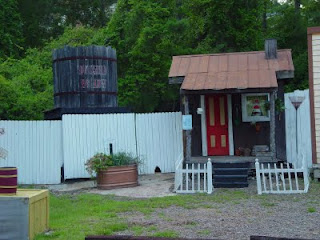In my quest of reinventing myself I am making an active effort to try new things. I have often heard of the fun involved with drumming circles. People speak of the relaxation, the spiritual calmness and the group togetherness.
Learning of a local drumming circle, I decided to check it out. The leaders brought a variety of drums and rattles. The main drum is what I am told is called a pow-wow drum. It is about three feet across and suspended from an x-shaped frame. It has a beautiful sound when struck. Four of us were playing it at once. One person leads off and the others try to match the rhythmic beat. I was mentally carried away with beat, it vibrated through my body leaving a "humming" feeling. This was FUN! Listening to one of the others playing a hand held hoop drum, I was fascinated by the sound. I made the comment that had to have one. Of course, I just planned on buying one somewhere.
The very next day I was surprised with the gift of a drum frame. It is steam-bent birch about 15 inches across and 3 inches high. This is nice...Oh-oh....I suddenly realized that this meant I had to make my drum! Not having ever seen one made and not having the circle's drums handy to check out, I searched the Internet for how-to hints, and found enough information to help calm my nervousness. Luckily, I found a local source for the raw-hide skin needed for the drum head. After worrying over it for a couple of days I finally just dove in and made the drum. I softened the rigid hide by soaking it in water for a few hours. Laying the wooden frame over it, I laced (tied) the hide to the frame with faux sinew. Not perfect but workable and I learned some things to pay more attention to on my next attempt of drum making. Oh yes, there will be another one.

BOTTOM:
...showing the lacing holding the head in place. It also acts as a handle to hold the drum when playing it. The traditional lacing pattern is generally finished in an X but this six-pointed star pattern worked out better for me.
 But all things considered, I am quite happy with the results.In the end, I decided to oil the skin instead of painting a design on it. The oil has made the drum head almost translucent and has deepened the tone.
But all things considered, I am quite happy with the results.In the end, I decided to oil the skin instead of painting a design on it. The oil has made the drum head almost translucent and has deepened the tone. See how the sun shines through it?

This style is one of the most basic of drums. Traditional skin drums made by some Native Americans are very close in design to the Celtic bodhrán as well as being similar to the frame drums distributed widely across northern Africa from the Middle East, and in instruments used for Arabic music and the musical traditions of the Mediterranean region.
~*~*~*~*~*~*~*~*~*~*~
"The drum is the Great Spirit's favorite instrument. That's why we were all given a heartbeat..."~ Mano, Navajo Elder
~*~*~*~*~*~*~*~*~*~*~*~
Here is some more info if you find that you are interested.
Shaman drum: http://www.beardrum.com/drumconstruction.html
Drum supplies: http://www.drum.com/
Making a simple drum: http://www.ihobf.org/download/Making_a_Drum.pdf

















































